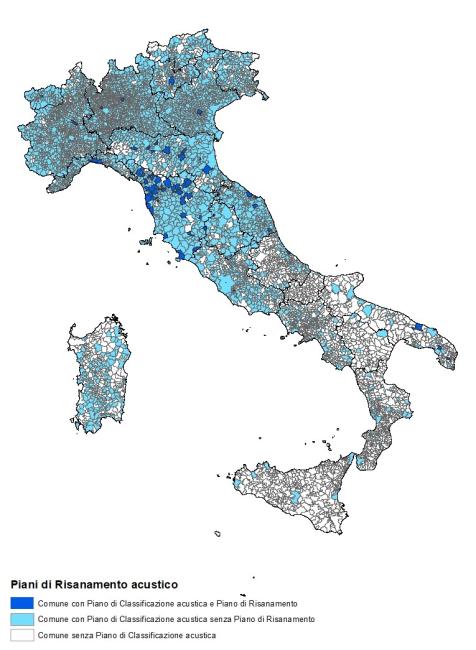Panel 1
Gabriele Bellabarba, Francesca Sacchetti
The Municipal Noise Mitigation Plan is legally established as a fundamental tool for managing and resolving noise pollution issues within a territory. This plan follows the primary municipal requirement: the Noise Zoning Plan. The Noise Mitigation Plan must be coordinated with all other urban planning tools and must incorporate the content of noise containment and reduction plans for transport infrastructure. As of 2023, this planning instrument remains scarcely implemented at the national level: only 66 out of 5,097 municipalities with an approved Noise Zoning Plan have also adopted a Noise Mitigation Plan, maintaining a percentage slightly above 1% over the years.
For each region/autonomous province, the indicator reports, , the number of municipalities with an approved Noise Zoning Plan, the number of municipalities that have approved a Noise Mitigation Plan, a list of these municipalities, and the corresponding year of plan approval.
To assess the implementation status of national noise regulations concerning municipal administrations’ activities related to planning and managing noise mitigation measures.
LQ 447/1995, DPCM 14/11/1997
Panel 2
APAT CTN_AGF 2005, Revisione delle Linee Guida per i Piani comunali di risanamento acustico
--
--
Data quality assessment
ARPA/APPA (Regional and Autonomous Provincial Environmental Protection Agencies)
The data for the processing of the indicator are available in the Noise Observatory database, which may be populated by the representatives of ARPA/APPA and can be accessed, including by the public, on the following website: https://agentifisici.isprambiente.it/osservatoriorumore_public/home.php.
National, Regional (20/20)
Update as of 31/12/2023
Indicator assessment
The indicator is based on the number of municipalities that have approved a Noise Mitigation Plan.
The approval of a Municipal Noise Mitigation Plan, a key instrument required by LQ 447/95 for managing and resolving noise pollution issues, remains uncommon, highlighting a weak response from local administrations. This issue is attributed to several factors, including the incomplete implementation of other acoustic planning tools (especially the Noise Zoning Plan), outdated national regulations, the lack of specific regional laws for noise pollution management, and the insufficient financial resources available to municipalities for mitigation interventions.
Although the number of municipalities with an approved Noise Zoning Plan has steadily increased over the years (from 3,304 in 2009 to 5,097 in 2023), this has not been accompanied by a corresponding increase in the number of municipalities that have approved a Noise Mitigation Plan.
As of now, only 66 municipalities have adopted a Noise Mitigation Plan (Table 1).
Data
Table 1: Municipalities, classified by Region/Autonomous Province, that have approved the Noise Mitigation Plan
ISPRA elaboration based on ARPA/APPA data

As of 2023, only 66 out of 5,097 municipalities with an approved Noise Zoning Plan have also adopted a Noise Mitigation Plan, maintaining a consistently low percentage (stable at 1.3% for several years) for this planning tool.
The majority of approved Noise Mitigation Plans are located in Tuscany, with 40 plans, representing 60.6% of all municipalities with a mitigation plan but only 15.3% of the total municipalities with a Noise Zoning Plan across the region (Table 1). As shown in Figure 1, the Noise Mitigation Plan remains largely unestablished and/or unimplemented planning instrument at the national level.